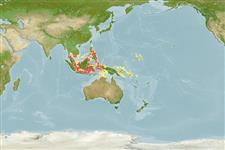Lớp phụ Cá sụn (cá mập và cá đuối) (sharks and rays) >
Orectolobiformes (Carpet sharks) >
Hemiscylliidae (Bamboo sharks)
Etymology: Hemiscyllium: hemi-, from hemisys (Gr.), half, presumably referring to similarity and/ or close affinity to Scyllium (=Scyliorhinus, now in Scyliorhinidae) and/or Chiloscyllium; skylion, Greek for dogfish or small shark. (See ETYFish); henryi: In honor of underwater photographer Wolcott Henry, who supported Conservation International’s marine initiatives, including the taxonomy of western New Guinea fishes. (See ETYFish).
Environment: milieu / climate zone / depth range / distribution range
Sinh thái học
Biển Cùng sống ở rạn san hô; Mức độ sâu 3 - 30 m (Ref. 74956). Tropical
Western Pacific: Known only from western New Guinea (Papua Barat Province), Indonesia.
Bộ gần gũi / Khối lượng (Trọng lượng) / Age
Maturity: Lm ? range ? - ? cm
Max length : 78.3 cm TL con đực/không giới tính; (Ref. 74956); 81.5 cm TL (female)
Short description
Hình thái học | Sinh trắc học
This species is distinguished by its unique colour pattern, distinctive is the combination of small scattered spots on the head, body and fins including 13-18 spots on the interorbital/dorsal snout region and 6-18 spots on dorsal surface of pectoral fins; a unique 'double-ocellus' marking on middle of side, just behind the head (Ref. 74956).
Observed and collected both in the bay and at nearby Selat Iris, a narrow channel between the mainland and Aiduma Island; where there is almost no shallow, fringing reef habitat due to the unique geomorphology. Thus, the typical habitat for this species extends into deeper water (at least 30 m), although it has also been sighted in depths less than 4 m. It is often seen resting on the bottom, occasionally observed slowly swimming or 'walking' over the bottom with the pectoral and pelvic fins. Generally sedentary during the day, sheltering under rocky outcrops or tabular corals (Ref. 74956).
Life cycle and mating behavior
Chín muồi sinh dục | Sự tái sinh sản | Đẻ trứng | Các trứng | Sự sinh sản | Ấu trùng
Allen, G.R. and M.V. Erdmann, 2008. Two new species of bamboo sharks (Orectolobiformes: hemiscylliidae) from Western New Guinea. aqua, Int. J. Ichthyol. 13(3-4):93-108. (Ref. 74956)
IUCN Red List Status (Ref. 130435)
Threat to humans
Harmless
Human uses
Thêm thông tin
Age/SizeSự sinh trưởngLength-weightLength-lengthLength-frequenciesSinh trắc họcHình thái họcẤu trùngSự biến động ấu trùngBổ xungSự phong phúBRUVS
Các tài liệu tham khảoNuôi trồng thủy sảnTổng quan nuôi trồng thủy sảnCác giốngDi truyềnElectrophoresesDi sảnCác bệnhChế biếnNutrientsMass conversion
Các công cụ
Special reports
Download XML
Các nguồn internet
Estimates based on models
Phylogenetic diversity index (Ref.
82804): PD
50 = 0.5020 [Uniqueness, from 0.5 = low to 2.0 = high].
Bayesian length-weight: a=0.00407 (0.00181 - 0.00918), b=3.09 (2.89 - 3.29), in cm total length, based on LWR estimates for this (Sub)family-body shape (Ref.
93245).
Mức dinh dưỡng (Ref.
69278): 3.5 ±0.3 se; based on size and trophs of closest relatives
Fishing Vulnerability (Ref.
59153): Moderate to high vulnerability (53 of 100).
